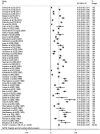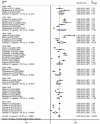Prevalence and trends of the abdominal aortic aneurysms epidemic in general population--a meta-analysis
- PMID: 24312543
- PMCID: PMC3846841
- DOI: 10.1371/journal.pone.0081260
Prevalence and trends of the abdominal aortic aneurysms epidemic in general population--a meta-analysis
Abstract
Objective: To conduct a meta-analysis assessing the prevalence and trends of the abdominal aortic aneurysms (AAA) epidemic in general population.
Method: Studies that reported prevalence rates of AAA from the general population were identified through MEDLINE, EMBASE, Web of Science, and reference lists for the period between 1988 and 2013. Studies were included if they reported prevalence rates of AAA in general population from the community. In stratified analyses possible sources of bias, including areas difference, age, gender and diameter of aneurysms were examined. Publication bias was assessed with Egger's test method.
Results: 56 studies were identified. The overall pooled prevalence of AAA was 4.8% (4.3%, 5.3%). Stratified analyses showed the following results, areas difference: America 2.2% (2.2%, 2.2%), Europe 2.5% (2.4%, 2.5%), Australia 6.7% (6.5%, 7.0%), Asia 0.5% (0.3%, 0.7%); gender difference: male 6.0% (5.3%, 6.7%), female 1.6% (1.2%, 1.9%); age difference: 55-64years 1.3% (1.2%, 1.5%), 65-74 years 2.8% (2.7%, 2.9%), 75-84 years1.2%(1.1%, 1.3%), ≥85years0.6% (0.4%, 0.7%); aortic diameters difference: 30-39 mm, 3.3% (2.8%, 3.9%), 40-49 mm,0.7% (0.4%,1.0%), ≥50 mm, 0.4% (0.3%, 0.5%). The prevalence of AAA has decreased in Europe from 1988 to 2013. Hypertension, smoking, coronary artery disease, dyslipidemia, respiratory disease, cerebrovascular disease, claudication and renal insufficiency were risk factors for AAA in Europe.
Conclusion: AAA is common in general population. The prevalence of AAA is higher in Australia than America and Europe. The pooled prevalence in western countries is higher than the Asia. Future research requires a larger database on the epidemiology of AAA in general population.
Conflict of interest statement
Figures




References
-
- Sakalihasan N, Limet R, Defawe OD (2005) Abdominal aortic aneurysm. Lancet 365: 1577–1589. - PubMed
-
- Gillum RF (1995) Epidemiology of aortic aneurysm in the United States. J Clin Epidemiol 48: 1289–1298. - PubMed
-
- Castleden WM, Mercer JC (1985) Abdominal aortic aneurysms in Western Australia: descriptive epidemiology and patterns of rupture. Br J Surg 72: 109–112. - PubMed
-
- Melton LJ 3rd, Bickerstaff LK, Hollier LH, Van Peenen HJ, Lie JT, et al. (1984) Changing incidence of abdominal aortic aneurysms: a population-based study. Am J Epidemiol 120: 379–386. - PubMed
-
- Wilmink AB, Quick CR (1998) Epidemiology and potential for prevention of abdominal aortic aneurysm. Br J Surg 85: 155–162. - PubMed
Publication types
MeSH terms
LinkOut - more resources
Full Text Sources
Other Literature Sources

